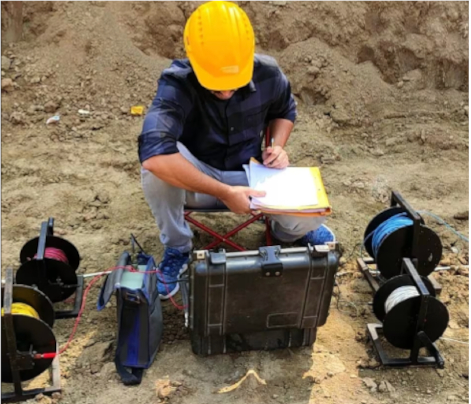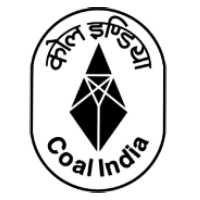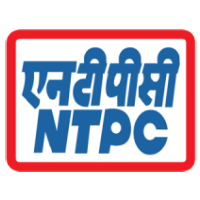Ground Water Survey Services for Borewell and Tubewell
Bhoojal survey team provides groundwater survey services to locate potential borewell drilling points and open well locations.
Groundwater survey can estimate depth of borewell for a good yield.
Borewell survey aims at finding out aquifer zones , water bearing zones and weathered rocks with water permeability within a given area .
At Bhoojal survey We analyse Lithological Map which is created to determine depth of borewell and strata details for effective drilling.
A team of hydrogeologist works on data collected from site and provide report on depth of borewell fracturted rock details and type of borewell to be drilled at a particular location
Groundwater survey services are termed as hydrogeological survey and geophysical survey services
Groundwater Survey Using Geophysical Instrument
Groundwater survey are conducted using geophysical Instruments i.e Resistivity instrument and Magnetic resonance based depending on site conditions.
Groundwater survey plays a crucial role in finding out locations for borewell for an optimal yield.
Most of the liquid freshwater resources are stored underground as groundwater (99%). The regional distribution on earth, however, varies and depends mainly on climatic conditions as well as the geology of the subsurface. In contrast to many raw materials, a great amount of the groundwater is recharged in the hydrologic cycle by infiltrating precipitation.
Our Successful Ground Water Surveys Testimonials
Bhoojal survey has successfully conducted thousands of survey work across India with excellent results. Services to major industries like, IOCL ,HPCL , John Deere , NMDC , NTPC, Reliance , HUL has been successfully provided by bhoojal’s team.

Groundwater survey using GER detect Instrument to locate underground water
A groundwater survey with GER detect instruments utilizes electrical resistivity principles to locate underground water. Electrodes are placed in the ground, and a small electrical current is passed between them while measuring potential differences. Variations in electrical resistivity across the survey area indicate the presence of groundwater; water conducts electricity better than rocks or soil.
This data is analyzed to create a subsurface model, revealing the depth, thickness, and location of underground water tables or aquifers. This method aids in vital tasks such as water resource management, well site selection, and assessing the sustainability of groundwater sources, making it invaluable for hydrogeological and environmental studies.

Gorundwater survey using resistivity instrument through Schlumberger method to determine low resistivity zone for drilling
Groundwater surveys employing the Schlumberger method with resistivity instruments are vital for locating low-resistivity zones, which often signify the presence of groundwater. This geophysical technique involves varying electrode spacings to measure electrical resistivity in subsurface formations.
Low-resistivity areas typically indicate water-rich zones or porous formations capable of storing water. Such surveys are invaluable for drilling operations, as they enable the precise identification of prime locations for accessing groundwater resources.
By targeting these low-resistivity zones, drillers can efficiently extract water, making this method crucial for sustainable water resource management and well placement decisions.


Borewell survey using PQWT instrument to determine feasible location for borewell drilling
A borewell survey conducted with the PQWT (Proton Quantity Water Detector) instrument is an essential step in identifying suitable locations for borewell drilling. The PQWT instrument utilizes nuclear magnetic resonance technology to assess the underground water quantity and quality. It sends electromagnetic pulses into the ground and analyzes the response to detect water-bearing layers and estimate water depth.
This survey helps determine the feasibility of borewell drilling by pinpointing areas with adequate groundwater resources. By selecting optimal drilling locations based on PQWT results, water availability can be maximized, ensuring the success and sustainability of borewell projects while conserving resources and minimizing drilling costs.
- 1. Geophysical Surveys: These include the utilization of electrical, attractive, and seismic strategies to decide the area and characteristics of underground water assets.
- 2. Hydrological Surveys: These involve the estimation of water levels, stream rates, and water quality in surface and underground water bodies.
- 3. Remote Sensing: This involves the use of satellite and aerial imagery to identify areas with potential for ground water availability.
- 4. Groundwater Modeling: This involves the use of computer simulations to predict groundwater flow and recharge rates in a given area.
FAQs: Groundwater Survey
1. What is an underground water survey?
An underground water survey is a scientific process that uses geophysical techniques and geological assessments to locate and assess subterranean water resources.
2. How do you test groundwater?
Groundwater is tested through sampling and laboratory analysis to determine its quality, including pH, contaminants, and mineral content.
3. What is a geophysical survey for groundwater?
A geophysical survey for groundwater employs methods like electrical resistivity, seismic waves, and magnetic fields to map underground water formations without drilling.
4. What are the methods of water survey?
Methods include geophysical surveys, drilling exploratory wells, hydrological mapping, and remote sensing technology.
5. What are the two types of underground water?
The two types are confined aquifers, where water is trapped between layers of impermeable material, and unconfined aquifers, where water seeps from the ground surface directly above it.
6. What is the formula for groundwater?
There isn't a specific "formula" for groundwater; its study involves calculations like Darcy's Law for flow rate: Q = KIA (where Q is the discharge, K is the hydraulic conductivity, I is the hydraulic gradient, and A is the area).
7. At which level groundwater is found?
Groundwater levels vary greatly depending on geological formations but can be found at depths ranging from just a few meters to several hundred meters below the surface.
8. What is water surveying?
Water surveying is the practice of mapping and analyzing water resources, including surface water and groundwater, to understand their extent, quality, and sustainability.
9. How do you check the ground water level?
Groundwater levels are checked by measuring the water depth in wells, using electronic water level meters, or observing fluctuations in piezometers installed in the ground.
People also search for
- 1. Groundwater survey Jaipur
- 2. Hydrogeological survey Jaipur
- 3. Jaipur Hydrogeology
- 4. CGWA NOC consultancy in Jaipur




















